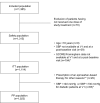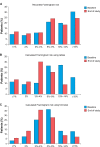Effect of eprosartan-based antihypertensive therapy on coronary heart disease risk assessed by Framingham methodology in Canadian patients: results of the POWER survey
- PMID: 24493928
- PMCID: PMC3908905
- DOI: 10.2147/VHRM.S55298
Effect of eprosartan-based antihypertensive therapy on coronary heart disease risk assessed by Framingham methodology in Canadian patients: results of the POWER survey
Abstract
Purpose/introduction: The Canadian Hypertension Education Program (CHEP) has identified blood pressure (BP) control as a key target for an overall reduction in cardiovascular disease risk. The POWER survey (Physicians' Observational Work on Patient Education According to their Vascular Risk) used Framingham methodology to investigate the impact of an angiotensin-receptor-blocker-based regimen on arterial BP and total coronary heart disease (CHD) risk in a subset of patients recruited in Canada.
Methods: 309 Canadian practices screened for patients with either newly diagnosed or uncontrolled mild/moderate hypertension (sitting systolic blood pressure [SBP] >140 mmHg with diastolic blood pressure [DBP] <110 mmHg). Treatment comprised eprosartan 600 mg/day with add-on antihypertensive therapy after 1 month if required. The primary efficacy variable was change in SBP at 6 months; the secondary variable was the absolute change in the Framingham 10-year CHD risk score.
Results: 1,385 patients were identified, of whom 1,114 were included in the intention-to-treat (ITT) cohort. Thirty-eight point four percent of ITT patients were managed with monotherapy at 6 months, versus 35.2% and 13.7% with two-drug or multiple-drug therapy, respectively. SBP in the ITT cohort declined 22.4 (standard deviation [SD] 14.8) mmHg and DBP declined 10.5 (SD 10.3) mmHg during that time. The absolute mean Framingham score declined 2.1 (SD 3.1) points with significant age and sex variation (P<0.001) and differences between the various Framingham methods used.
Discussion/conclusion: Primary care physicians were able to use a strategy of BP lowering and CHD risk assessment to achieve significant reductions in BP and Framingham-assessed CHD risk. The effect size estimate of the different Framingham methods varied noticeably; reasons for those differences warrant further investigation.
Keywords: angiotensin-receptor blocker; blood pressure; hypertension; observational study.
Figures




References
-
- Daskalopoulou SS, Khan NA, Quinn RR, et al. Canadian Hypertension Education Program The 2012 Canadian hypertension education program recommendations for the management of hypertension: blood pressure measurement, diagnosis, assessment of risk, and therapy. Can J Cardiol. 2012;28:270–287. - PubMed
-
- Padwal RS, Hemmelgarn BR, Khan NA, et al. Canadian Hypertension Education Program The 2009 Canadian Hypertension Education Program recommendations for the management of hypertension: Part 1 – blood pressure measurement, diagnosis and assessment of risk. Can J Cardiol. 2009;25:279–286. - PMC - PubMed
-
- Wilson PW, D’Agostino RB, Levy D, Belanger AM, Silbershatz H, Kannel WB. Prediction of coronary heart disease using risk factor categories. Circulation. 1998;97:1837–1847. - PubMed
Publication types
MeSH terms
Substances
LinkOut - more resources
Full Text Sources
Other Literature Sources
Medical

